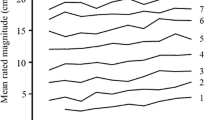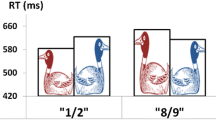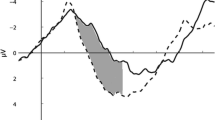Abstract
Although the spatial representation of number (mental number line) is well documented, the scaling associated with this representation is less clear. Sometimes people appear to rely on compressive scaling, and sometimes on linear scaling. Here we provide evidence for both compressive and linear representations on the same numerical bisection task, in which adult participants estimate (without calculating) the midpoint between two numbers. The same leftward bias (pseudoneglect) shown on physical line bisection appears on this task, and was previously shown to increase with the magnitude of bisected numbers, consistent with compressive scaling (Longo and Lourenco in Neuropsychologia 45:1400–1407, 2007). In the present study, participants held either small (1–9) or large (101–109) number primes in memory during bisection. When participants remembered small primes, bisection responses were consistent with compressive scaling. However, when they remembered large primes, responses were more consistent with linear scaling. These results show that compressive and linear representations may be accessed flexibly on the same task, depending on the numerical context.


Similar content being viewed by others
References
Banks WP, Coleman MJ (1981) Two subjective scales of number. Percept Psychophys 29:95–105
Banks WP, Hill DK (1974) The apparent magnitude of number scaled by random production. J Exp Psychol Monograph 102:353–376
Bartolomeo P, Thiebaut de Schotten M, Doricchi F (2007) Left unilateral neglect as a disconnection syndrome. Cereb Cortex 17:2479–2490
Bisiach E, Vallar G (2000) Unilateral neglect in humans. In: Boller F, Grafman J, Rizzolatti G (eds) Handbook of neuropsychology, 2nd edn. Elsevier, Amsterdam, pp 459–502
Booth JL, Siegler RS (2006) Developmental and individual differences in pure numerical estimation. Dev Psychol 41:189–201
Brannon EM, Wusthoff CJ, Gallistel CR, Gibbon J (2001) Numerical subtraction in the pigeon: evidence for a linear subjective number scale. Psychol Sci 12:238–243
Dehaene S (1997) The number sense: how the mind creates mathematics. Oxford University Press, Oxford
Dehaene S (2001) Subtracting pigeons: logarithmic or linear? Psychol Sci 12:244–246
Dehaene S (2008) Symbols and quantities in parietal cortex: elements of a mathematical theory of number representation and manipulation. In: Haggard P, Rossetti Y, Kawato M (eds) Sensorimotor foundations of higher cognition: attention and performance XXII. Oxford University Press, Oxford, pp 527–574
Dehaene S, Mehler J (1992) Cross-linguistic regularities in the frequency of number words. Cognition 43:1–29
Dehaene S, Bossini S, Giraux P (1993) The mental representation of parity and number magnitude. J Exp Psychol Gen 122:371–396
Dehaene S, Izard V, Spelke E, Pica P (2008) Log or linear? distinct intuitions of the number scale in Western and Amazonian indigene cultures. Science 320:1217–1220
Doricchi F, Guariglia P, Gasparini M, Tomaiuolo F (2005) Dissociation between physical and mental number line bisection in right hemisphere brain damage. Nat Neurosci 8:1663–1665
Elbert T, Pantev C, Wienbruch C, Rockstroh B, Taub E (1995) Increased cortical representation of the fingers of the left hand in string players. Science 270:305–307
Fischer MH, Castel AD, Dodd MD, Pratt J (2003) Perceiving numbers causes spatial shifts of attention. Nat Neurosci 6:555–556
Gallistel CR, Gelman R (1992) Preverbal and verbal counting and computation. Cognition 44:43–74
Gallistel CR, Gelman R (2000) Non-verbal numerical cognition: from reals to integers. Trends Cogn Sci 4:59–65
Jewell G, McCourt ME (2000) Pseudoneglect: a review and metaanalysis of performance factors in line bisection tasks. Neuropsychologia 38:93–110
Loetscher T, Schwarz U, Schubiger M, Brugger P (2008) Head turns bias the brain’s internal random generator. Curr Biol 18:R60–R62
Longo MR, Lourenco SF (2007) Spatial attention and the mental number line: evidence for characteristic biases and compression. Neuropsychologia 45:1400–1407
Nieder A (2005) Counting on neurons: the neurobiology of numerical competence. Nat Rev Neurosci 6:177–190
Nieder A, Miller EK (2003) Coding of cognitive magnitude: compressed scaling of numerical information in the primate prefrontal cortex. Neuron 37:149–157
Oldfield RC (1971) The assessment and analysis of handedness: the Edinburgh inventory. Neuropsychologia 9:97–113
Pia L, Corazzini LL, Folegatti A, Gindri P, Cauda F (2009) Mental number line disruption in a right-neglect patient after a left-hemisphere stroke. Brain Cogn (in press)
Piazza M, Izard V, Pinel P, Le Bihan D, Dehaene S (2004) Tuning curves for approximate numerosity in the human intraparietal sulcus. Neuron 44:547–555
Shaki S, Fischer MH (2008) Reading space into numbers––a cross-linguistic comparison of the SNARC effect. Cognition 108:590–599
Siegler RS, Booth JL (2004) Developmental of numerical estimation in young children. Child Dev 75:428–444
Siegler RS, Opfer JE (2003) The development of numeral estimation: evidence for multiple representations of numerical quantity. Psychol Sci 14:237–243
van Oeffelen MP, Vos PG (1982) A probabilistic model for the discrimination of visual number. Percept Psychophys 32:163–170
Whalen J, Gallistel CR, Gelman R (1999) Nonverbal counting in humans: the psychophysics of number representation. Psychol Sci 10:130–137
Zorzi M, Priftis K, Umiltà C (2002) Neglect disrupts the mental number line. Nature 417:138–139
Zorzi M, Priftis K, Meneghello F, Marenzi R, Umiltà C (2006) The spatial representation of numerical and non-numerical sequences: evidence from neglect. Neuropsychologia 44:1061–1067
Acknowledgments
The authors would like to thank Dede Addy, Lily Stutman, Julie Laderberg, and Shaina Gordon at Emory University for help with testing, coding data, or both.
Author information
Authors and Affiliations
Corresponding author
Rights and permissions
About this article
Cite this article
Lourenco, S.F., Longo, M.R. Multiple spatial representations of number: evidence for co-existing compressive and linear scales. Exp Brain Res 193, 151–156 (2009). https://doi.org/10.1007/s00221-008-1698-9
Received:
Accepted:
Published:
Issue Date:
DOI: https://doi.org/10.1007/s00221-008-1698-9




